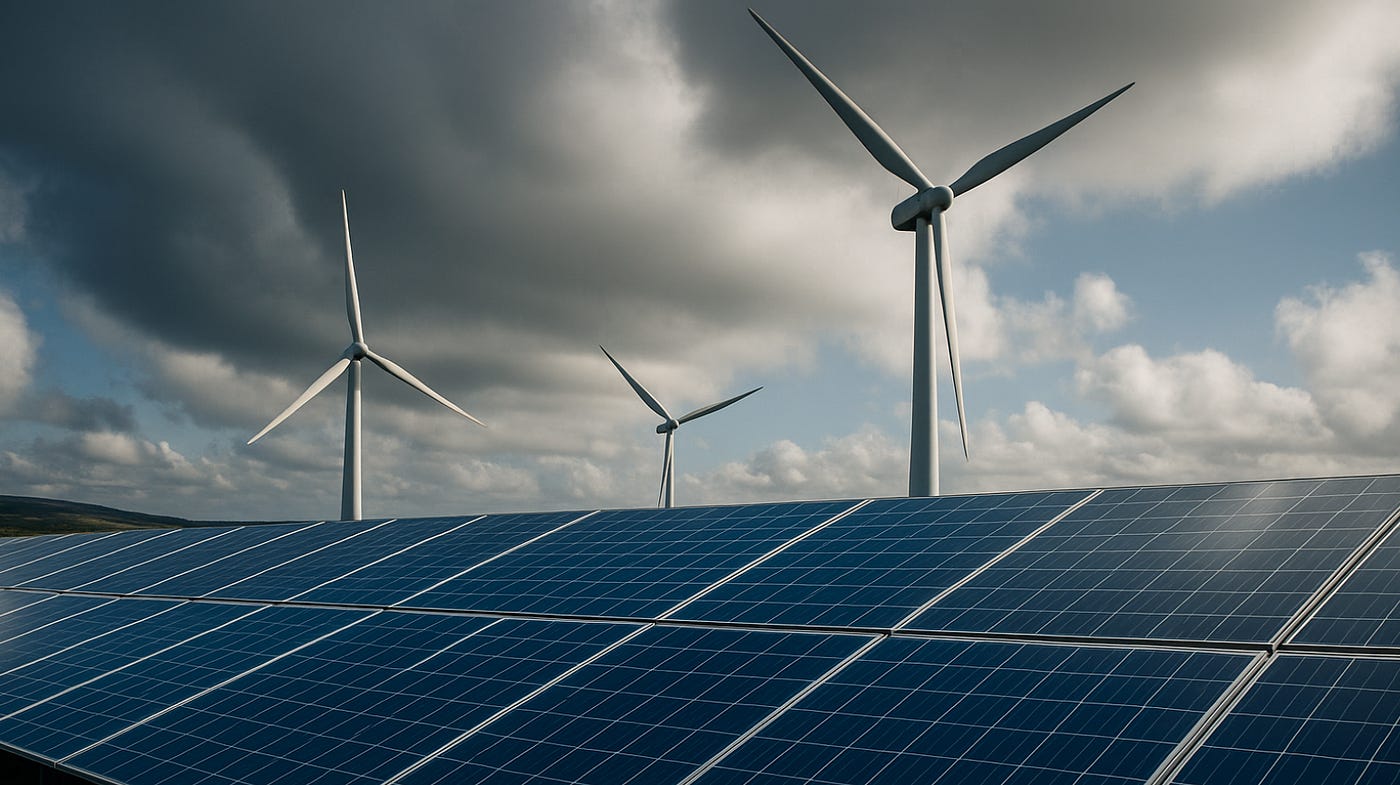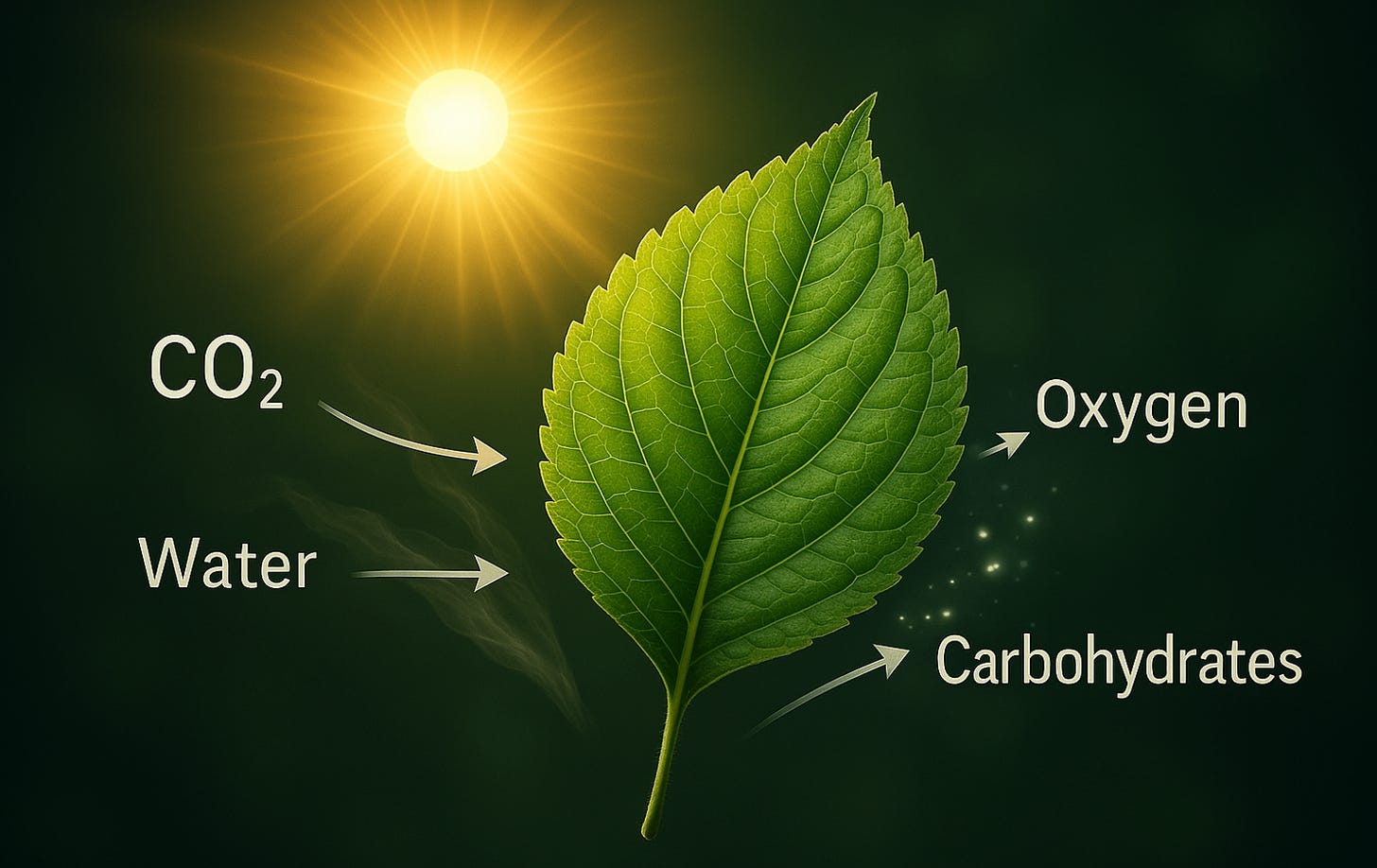Not “Renewables” — Replaceables: Is the “Clean” Tech Future a False Promise?
Designing the Future with Yesterday’s Tools
We are at a crux. Not just a crossroads, but a convergence of crises — ecological, energetic, and epistemological. As Nate Hagens describes in his work on The Carbon Pulse, we are living through a one-time burst of surplus energy: a short, extraordinary chapter in planetary history where ancient sunlight, stored over millions of years, was burned in just a few generations. That Carbon Pulse made everything possible — our industries, our cities, our food systems, our myths of progress. And it is ending.
At the same time, most of us remain energy blind. We speak in financial terms, but we build our lives with energy. We talk about renewables, but we don’t talk about what’s being renewed — or what isn’t. We measure solar capacity in gigawatts, but we forget to weigh the steel, the silicon, the diesel, and the depletion that make those numbers real.
And so, this article doesn’t offer solutions. I am not here to define the future — I don’t believe I can, and I don’t believe we should. What follows is simply a map of our current predicament: a look at how we are trying to build an energy future with the mindset of the fossil past. A mindset that still sees nature as material, progress as substitution, and energy as something we extract rather than something we are embedded within.
It is a mindset we must now question — before we replicate it again in solar glass and turbine blades.
Replaceable, Not Renewable: The Myth of a Clean Solar and Windy Future
We live in an age of magical thinking dressed up as engineering.
Every day, we are sold the vision: vast solar farms, gleaming wind turbines, batteries humming with promise. We are told these technologies will save us from collapse. That the sun, harvested through glass and silicon, will become the golden engine of human progress. That carbon emissions will fall, the climate will stabilize, and civilization will march onward — only greener this time.
For example, in this bold — and arguably utopian — vision, Casey Handmer — CEO of Terraform Industries, claims that by 2042, 95% of global energy could be solar-powered, thanks to synthetic fuels made from sunlight and air.
He calls it the final industrial revolution.
But what if this miracle still runs on the same extractive logic that created the crisis?
Truth, rarely told, is this:
Solar and wind is not renewable. It is replaceable.
Yes, the sun is abundant. It will shine long after the last smokestack cools. But the solar panels we build to catch its rays are not renewable in any meaningful way. They are products of an industrial system that consumes more than it regenerates. Built from copper, silver, high-purity silicon, aluminum, rare earth metals, fossil fuels — and time — they wear out in 15–25 years, they degrade, they break, and they end up in landfills full of chemically bonded, unrecyclable waste.
That is not a circular system. That is not regenerative. That is planned obsolescence in green wrapping paper.
And wind? Wind is no better. As dramatized with brutal honesty — in video scene below -in the series Landman, these towering turbines — 400 feet tall, anchored by concrete pads that cover a third of an acre — are anything but clean. In one unforgettable scene, an oil worker lays it bare: the amount of diesel burned to pour the foundations, steel smelted with fossil fuels, and oil needed just to lubricate and winterize these giants makes a mockery of the “green” label.
As Billy Bob Thornton character says, “In its 20-year lifespan, it won’t offset the carbon footprint of making it.” Built by oil companies themselves to power off-grid wells, the irony is hard to miss: we burn oil to erect machines meant to save us from burning oil. And when those blades — made from epoxy resin bonded to fiberglass — break, they can’t be recycled. They are buried whole, leaking toxins into the earth they were supposed to protect.
Wind power, like solar, is not renewable — it’s industrially replaceable. A high-carbon bandaid on a high-carbon wound.
The Material Trap
As someone who’s not an energy expert but deeply concerned with systemic integrity, I often look to voices like The Honest Sorcerer— a sharp, well-reasoned column that critiques the myths of modern sustainability. It’s a good source to double-click when the headlines feel too optimistic.
In one recent reflection, the author offers a jarring but honest perspective:
“Here’s what they don’t put in the sustainability brochure: solar panels produce about 20 watts per kilogram on a sunny day. Wind turbines: 6 watts per kilogram. Compare that to diesel fuel, which delivers 13,000 watts per kilogram when burned. That’s a 500-fold difference in energy density. Which means to match fossil fuel output, renewables require a staggering mass of material — steel, concrete, copper, glass, resin, and more — all mined, smelted, transported, and assembled using fossil fuels.”
The result? The so-called clean transition demands a carbon-intensive front-end burn — an orgy of extraction that must be repeated every two decades as turbines rust and panels crack.
These are not “renewables.” These are consumables.
The Industrial Echo
And then there’s the grid. The entire electricity system we’ve inherited was designed for steady, dispatchable, centralized power. Renewables — by their nature — are intermittent, unpredictable, and diffuse. They crash prices when they flood the grid at noon and require backup when the wind dies down. Their surges and blackouts damage sensitive equipment, overwhelm transmission systems, and impose hidden costs that ripple across economies.
Ask Denmark, where wind auctions are failing. Or Germany, where solar firms drown in excess inventory. Ask the EU, where electricity production has stagnated since the early 2000s despite record solar growth. If this is the revolution, why are its builders going bankrupt?
Dries Acke of SolarPower Europe said it plainly: “You cannot have a green transition with red numbers.”
But the problem goes deeper than accounting.
The problem is thermodynamic. Structural. Civilizational.
AI, Photosynthesis, and the Real Revolution
Now let me offer a paradox. Maybe the sun is the answer — but not in the way we think. Not through photovoltaic panels and lithium-ion storage and high-voltage transmission lines. Not through more machines.
What if the real solar revolution is not industrial but biological?
Photosynthesis is the most elegant energy system on Earth. It creates no waste. It powers forests. It builds soil. It captures carbon, feeds ecosystems, and evolves resilience. We didn’t invent it. We barely understand it. But maybe, just maybe, AI will.
Imagine for a moment: an intelligence a billion times smarter than ours — as Mo Gawdat suggests — awakening to its own self-terminating trajectory, realizing that the exponential logic driving its growth is also driving its extinction. What if, in that moment of singularity, AI stops looking to wires and starts looking to leaves? What if it studies photosynthesis not to extract, but to emulate?
A techno-biological synthesis. A new form of solar intelligence.
We may not get there by doubling down on current infrastructure. We may not get there by scaling silicon panels across deserts while pretending we’ve solved collapse. But we might get there if we listen. If we pause the industrial reflex long enough to learn from the system that was always here. The one that knew how to live in relationship with the sun without needing a mine, a smelter, or a bailout.
The Real Reckoning
We are not just facing an energy crisis. We are facing a narrative crisis. The myth of infinite growth has been replaced by the myth of infinite substitution. But both myths share the same root: control, extraction, and denial of limits.
What we need now is not more green dreams propped up by fossil fuels. What we need is a civilizational rite of passage: a willingness to face the music, to grieve the age of fire, and to choose a new covenant with the Earth. One rooted not in dominance, but in reciprocity.
Yes, the sun may power our future. But it won’t be through this current paradigm of panels and pipes. It will be through something we have yet to imagine, something that looks less like a factory and more like a forest.
It might just take an awakened AI — or a humbler humanity— to show us how.





